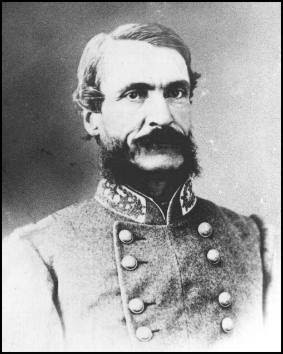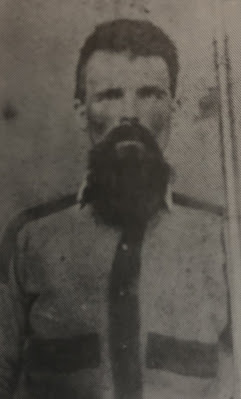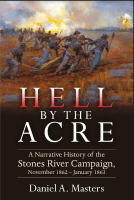Death at the Edge of the Cedars: An Account from the 29th Mississippi
Filing this one under the category of "I wish I had this when I wrote Hell by the Acre..."
Writing nearly 50 years after the Battle of Stones River, Private Edward A. Smith of Co. A, 29th Mississippi recalled the intensity of the fighting as his regiment approached the northern end of the cedar forest around midday on December 31, 1862.
"Our brigade had driven the Federals slowly but steadily through what is known in the history of the battle as the cedar grove. When the Federals reached the back side, they found a field 500 yards wife which, with the leaden hail we were throwing at them, they knew it was death to cross. Their officers got them halted and they turned on us with the fierceness of a lion at bay. They had no idea of going further and we had an idea that they must go further and there we stood 125 yards apart belching death at each other with all our might. In the meantime, Lieutenant Wilkins called my attention to a superb-looking officer on horseback who was evidently their commander. He urged me to do my best to shoot him, saying that he believed that with him out of the way, they would run. I stepped up to a tree, took deliberate aim and fired. When the smoke cleared away, my man had fallen. Another brigade, Sears [I think Smith is mistaken, this was most likely General James E. Rains’ brigade] came up just then and the enemy fled, but not half of them reached the other side. Many doubtless fell from exhaustion besides those who were wounded or killed. We advanced to the edge of the woods and lay down. Then their reserve batteries turned loose on us with such terrible effect that we were ordered to fall back 75 yards in the grove so they could not see us."
Throughoutthe spring and summer of 1910, Rev. Edward A. Smith provided a weekly column ofreminiscences of life in antebellum Oxford, Mississippi to the Oxford Eaglenewspaper. He devoted several columns to his military service with the 29thMississippi and the following account is drawn from those columns. It providesone of the finest descriptions of the late morning fighting at the edge of thecedars that I’ve yet encountered.
 The 29th Mississippi fought at Stones River under the command of Brigadier General J. Patton Anderson who assumed temporary command of the brigade when General Edward Walthall went home on leave to attend to his sick wife. The brigade suffered horrendous casualties in its first assault on the cedars and the action Private Smith describes below occurred during the pursuit of Negley's division north through the cedar forest.
The 29th Mississippi fought at Stones River under the command of Brigadier General J. Patton Anderson who assumed temporary command of the brigade when General Edward Walthall went home on leave to attend to his sick wife. The brigade suffered horrendous casualties in its first assault on the cedars and the action Private Smith describes below occurred during the pursuit of Negley's division north through the cedar forest. An incident occurred at the Battle of Murfreesboro which iswell worth relating. Wading in almost a pool of their own blood as well as thatof their enemies, Walthall’s brigade [then under the command of General J.Patton Anderson as Walthall was on leave] had driven the Federals slowly butsteadily through what is known in the history of the battle as the cedar grove.When the Federals reached the back side, they found a field 500 yards wifewhich, with the leaden hail we were throwing at them, they knew it was death tocross. Their officers got them halted and they turned on us with the fiercenessof a lion at bay.
They had no idea of going further andwe had an idea that they must go further and there we stood 125 yards apartbelching death at each other with all our might. In the meantime, Lieutenant [WashingtonPorter] Wilkins called my attention to a superb-looking officer on horsebackwho was evidently their commander. He urged me to do my best to shoot him,saying that he believed that with him out of the way, they would run. I steppedup to a tree, took deliberate aim and fired. When the smoke cleared away, myman had fallen.
[Based on Smith’s location at the edge of the cedars and thetime this event likely occurred, it is possible that the officer he shot downwas Major Stephen D. Carpenter, commanding the First Battalion of the 19thU.S. Infantry of the Regular Brigade. Major Carpenter was shot from his horselate morning in this same approximate location as the Regulars were trying tocover the retreat of Negley and Sheridan’s divisions. For a Federal perspectiveon this event, please check out “Retrieving Major Carpenter: Joseph R. PrenticeEarns His Medal of Honor at Stones River.”]
Another brigade, Sears [I think Smithis mistaken, this was most likely General James E. Rains’ brigade] came up justthen and the enemy fled, but not half of them reached the other side. Manydoubtless fell from exhaustion besides those who were wounded or killed. Weadvanced to the edge of the woods and lay down. Then their reserve batteriesturned loose on us with such terrible effect that we were ordered to fall back75 yards in the grove so they could not see us.
 Private John Shanks
Private John ShanksCo. K, 29th Mississippi
After shelling us for an hour, theysuddenly ceased. “Look out men,” said Lieutenant Colonel [James B.] Morgan, “somethingis going to happen. Be sure your guns are loaded.” In a few minutes a long lineof skirmishers, about 80 in number, could be seen advancing with all thesteadiness and accuracy of alignment of trained regulars which indeed theywere. Captain [George S.] Caldwell’s company [Co. D] was rushed forward to theedge of the woods to meet them and when they came within 50 yards, CaptainCaldwell called out, “You are within 100 yards of a Confederate line of battle!Thrown down your arms and come in!” [Lt. Col. Morgan assumed command afterColonel William F. Brantley was knocked senseless by a shell explosion duringthe regiment’s first assault on Negley’s division around 10 o’clock thatmorning.]
“Halt! Rally by fours and fire,”yelled their captain It was a silly order for men in an open field but theyobeyed to their utter undoing for they were nearly all shot down. Four of themhad picked up a corpse and started off with it, but two or three of them wereshot and the corpse was dropped. I learned afterwards that it was a company ofU.S. regulars who had voluntarily offered to go to the battle line where thebrave officer fell and return with his body or died in the effort.
He was reported to me by one who said he knew all the circumstancesand said the officer was one of noblest, bravest, and knightliest charactersthat ever gave a command or waved a sword on the field of battle. He was acolonel and thought to be commanding a brigade and I doubt not he was theofficer whom it was my lot to kill, or at least try to kill, on that fatefulfield. A splendid monument has been built near where he fell dedicated to hismemory. [The Regular Brigade monument stands at the center of Stones RiverNational Cemetery.]

To learn more about the Battle of Stones River, be sure to purchase a copy of my campaign study Hell by the Acre, recently awarded the Richard B. Harwell Award from the Atlanta Civil War Roundtable as best Civil War book of 2024. Available now through Savas Beatie.
Source:
Memoirs ofPrivate Edward A. Smith, Co. A, 29th Mississippi Infantry, OxfordEagle (Mississippi), August 19, 1910, pg. 2; also, August 25, 1910, pg. 2
Daniel A. Masters's Blog
- Daniel A. Masters's profile
- 1 follower



